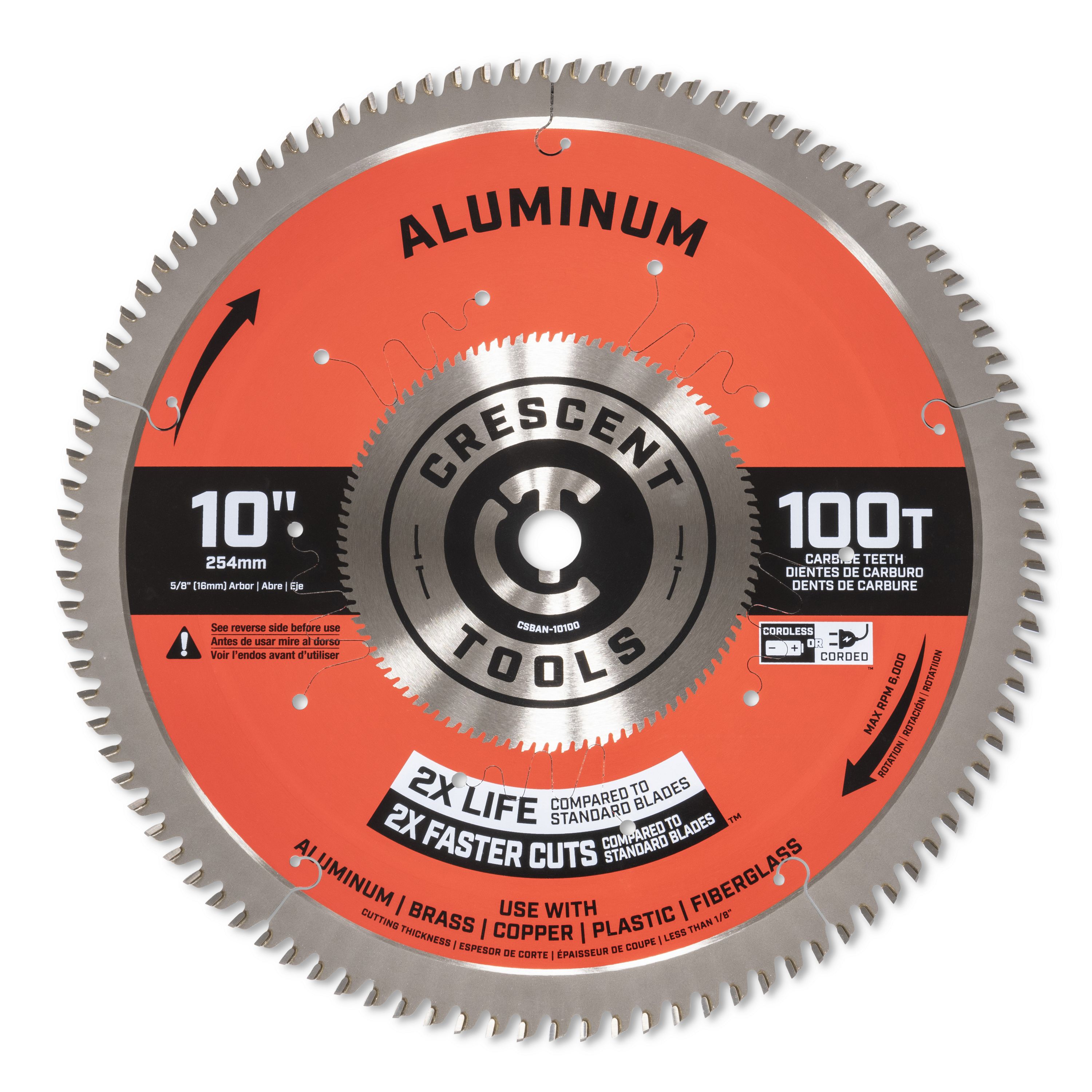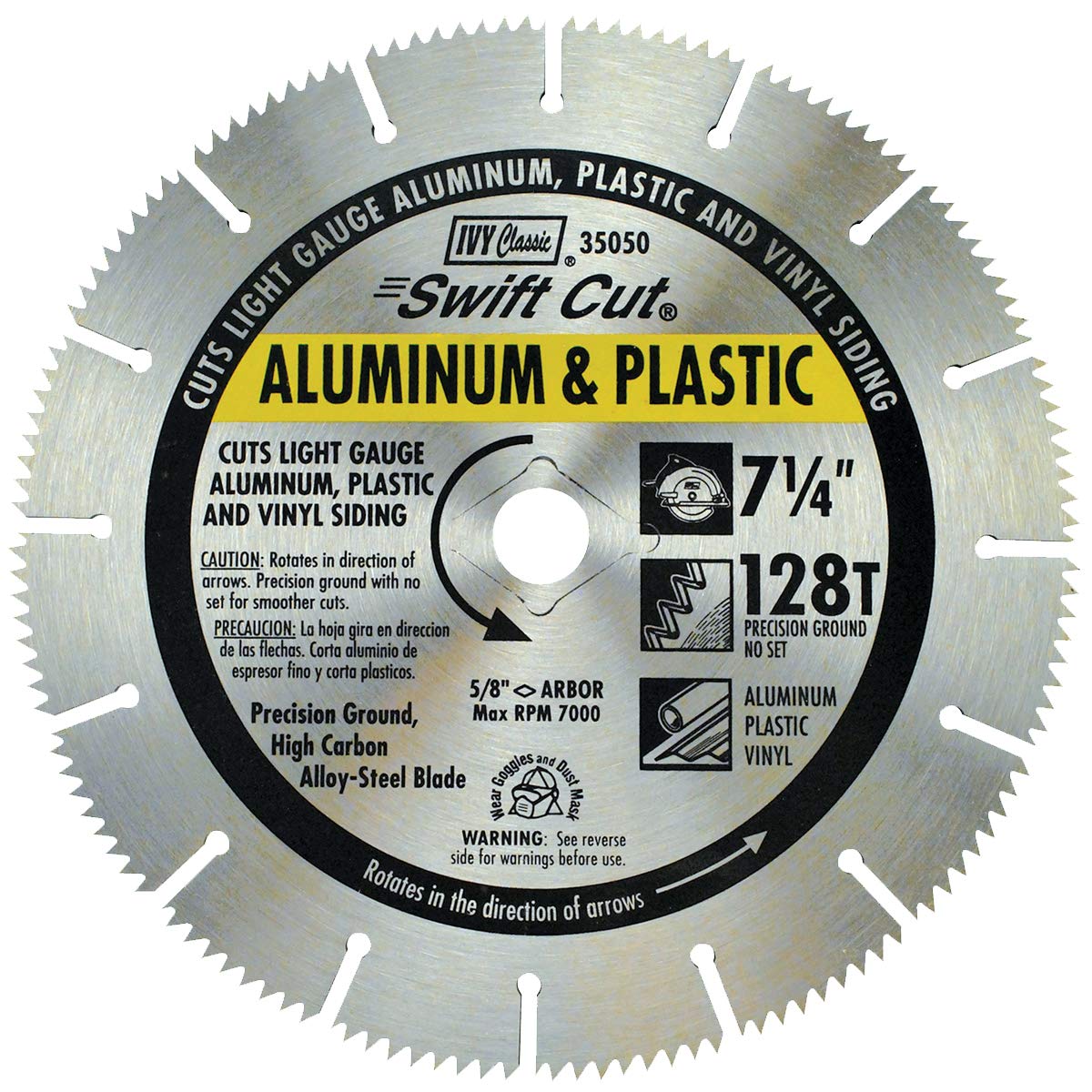Are you wondering what circular saw blade you should use for cutting aluminum? Well, you’ve come to the right place! Cutting aluminum requires a specific type of blade to ensure clean and precise cuts. In this article, we’ll explore the best circular saw blade for cutting aluminum, so you can tackle your projects with confidence.
When it comes to working with aluminum, using the right tool is crucial. The type of blade you choose can make a significant difference in the quality of your cuts. A dull or unsuitable blade can lead to rough edges, chipping, and even damage to your saw. That’s why it’s essential to select a circular saw blade specifically designed for cutting aluminum.
So, what circular saw blade should you look for? The ideal blade for cutting aluminum is typically made of carbide-tipped teeth. Carbide is a strong and durable material that can withstand the high heat generated during the cutting process. This type of blade ensures smooth, clean cuts in aluminum and helps prevent any material buildup or melting.
Now that you know the importance of using the right circular saw blade, let’s delve deeper into the different features and considerations to keep in mind when selecting the best blade for cutting aluminum. Whether you’re a DIY enthusiast or a professional contractor, this article will equip you with the knowledge you need to make an informed choice. Let’s get started!
When cutting aluminum with a circular saw, it’s important to choose the right blade. Opt for a carbide-tipped blade specifically designed for non-ferrous metals like aluminum. These blades have teeth made of carbide, a durable material that can handle the abrasive nature of aluminum. Look for a blade with a high tooth count for smoother cuts. Remember to wear appropriate safety gear and take necessary precautions when working with power tools.

What Circular Saw Blade is Best for Cutting Aluminum?
When it comes to cutting aluminum with a circular saw, choosing the right saw blade is crucial. Using the wrong blade can result in poor cuts, increased risk of accidents, and damage to both the blade and the material. In this article, we will delve into the world of circular saw blades for cutting aluminum and discuss the various factors to consider when making your choice. Whether you’re a professional or a DIY enthusiast, understanding the different types of blades available and their specific applications will ensure that your aluminum cutting projects are a success.
Different Types of Circular Saw Blades for Cutting Aluminum
Before we delve into the specific types of circular saw blades suitable for cutting aluminum, it’s important to understand the basics. Circular saw blades for cutting aluminum come in various sizes, tooth configurations, and materials. The most common types include:
1. Aluminum Cutting Blades
Aluminum cutting blades are specifically designed to cut through aluminum and other non-ferrous metals. These blades feature a special tooth geometry that prevents aluminum chips from clogging the teeth, ensuring clean and precise cuts. They usually have a high tooth count, typically ranging from 60 to 100 teeth, to minimize blade vibration and reduce the risk of chipping or burring the material.
When using an aluminum cutting blade, it’s essential to maintain a steady feed rate and avoid applying excessive pressure, as aluminum is a soft metal that can easily deform. With the right technique, an aluminum cutting blade can provide excellent results with minimal effort.
2. Carbide-tipped Blades
Carbide-tipped blades are another popular choice for cutting aluminum. These blades are equipped with carbide teeth, which are extremely hard and durable. The carbide tips are brazed onto the blade body, allowing for an aggressive cutting action and prolonged blade life.
Carbide-tipped blades are known for their versatility and can be used to cut a variety of materials, including aluminum. They provide clean, fast, and precise cuts, making them a favorite among professionals who work with different materials. Depending on the specific blade, they can have a tooth count ranging from 24 to 80 teeth.
Factors to Consider When Choosing a Circular Saw Blade for Cutting Aluminum
1. Blade Diameter
The blade diameter determines the size of the cut you can make. For cutting aluminum, common blade diameters range from 7-1/4 inches to 12 inches. The choice of diameter depends on the thickness of the aluminum material and the available cutting depth of your circular saw.
2. Tooth Count
The tooth count affects the quality of the cut and the speed of the cutting process. For cutting aluminum, blades with a higher tooth count generally provide smoother cuts, while blades with fewer teeth cut faster but may result in a rougher finish. Consider the thickness and density of the aluminum material when selecting the tooth count of your blade.
3. Blade Material
The material from which the blade is made determines its durability and cutting performance. Blades made from high-quality materials like carbide or high-speed steel (HSS) are ideal for cutting aluminum. These materials offer excellent heat resistance, ensuring that the blade stays sharp and performs optimally even with prolonged use.
4. Blade Design
The design of the blade, including the tooth configuration and the presence of special features, can greatly impact the cutting process. Blades with anti-kickback shoulders or laser-cut expansion slots help prevent accidents and reduce blade vibration. Consider these design features for enhanced safety and ease of use.
Proper Techniques for Cutting Aluminum With a Circular Saw
1. Wear Protective Gear
Prior to starting any cutting project, it’s crucial to wear appropriate safety gear. This includes safety glasses, hearing protection, and gloves. Aluminum chips and debris can be hazardous, so taking the necessary precautions is essential.
2. Measure and Mark Your Cuts
Before making any cuts, carefully measure and mark the aluminum material. Use a straight edge or a square to ensure accuracy. This step helps guide your saw along the correct path, resulting in precise cuts.
3. Secure Your Workpiece
Ensure that the aluminum material is firmly secured in place before starting the cutting process. This prevents the material from shifting or vibrating during the cut, reducing the risk of accidents and ensuring cleaner cuts.
4. Guide and Steady Your Saw
When cutting aluminum, it’s important to guide the circular saw smoothly and maintain a steady hand. Let the blade do the work and avoid applying excessive force. Take your time and follow the marked line with precision, allowing the saw to cut through the material at its own pace.
5. Use Proper Feed Rate
Applying the right feed rate is crucial for achieving clean and accurate cuts in aluminum. Pushing the material too quickly can cause the blade to bind or chip the aluminum, while moving too slowly may result in rough or jagged cuts. It’s important to find the right balance and maintain a consistent feed rate throughout the cut.
Conclusion
Choosing the right circular saw blade for cutting aluminum is essential for achieving clean, accurate, and efficient cuts. When selecting a blade, consider factors such as blade diameter, tooth count, material, and design. Additionally, implementing proper cutting techniques, wearing protective gear, and ensuring the correct feed rate will contribute to a successful cutting experience. Remember to always prioritize safety and take the time to understand the capabilities of different blades to optimize your cutting results and prolong the life of your saw.
Key Takeaways: What Circular Saw Blade for Cutting Aluminum?
- Choose a circular saw blade with carbide-tipped teeth for cutting aluminum.
- Look for a blade with the right number of teeth, around 80 to 100, for smooth and efficient cutting.
- Ensure the blade has a negative hook angle to prevent grabbing and kickback during cutting.
- Opt for a blade specifically designed for non-ferrous metals like aluminum for better results.
- Consider using a lubricant or cutting fluid to reduce heat and prolong blade life.
Frequently Asked Questions
Welcome to our Frequently Asked Questions section, where we provide answers to common queries about choosing a circular saw blade for cutting aluminum. Whether you’re a beginner or a seasoned DIY enthusiast, we’ve got you covered!
1. Can I use any circular saw blade to cut aluminum?
Not all circular saw blades are suitable for cutting aluminum. You’ll need a specialized blade with the right tooth design and material. Look for blades specifically labeled for cutting non-ferrous metals like aluminum. These blades are typically made of carbide or carbide-tipped, which can handle the rigors of cutting through aluminum while maintaining sharpness.
Using the wrong type of blade can result in poor cuts, excessive heat buildup, and even damage to your saw. Be sure to invest in a quality aluminum cutting blade to achieve clean, precise cuts.
2. How do I choose the right circular saw blade for cutting aluminum?
When selecting a circular saw blade for cutting aluminum, there are a few factors to consider. Firstly, ensure the blade is designed for non-ferrous metals like aluminum. Look for blades labeled for cutting aluminum or non-ferrous metals specifically.
Next, consider the tooth design. Opt for a blade with a high tooth count, preferably 80 or more, to achieve smoother cuts. Blades with less than 80 teeth can still cut aluminum, but the finish may not be as clean.
3. Can I use a regular wood-cutting blade for cutting aluminum?
Using a regular wood-cutting blade to cut aluminum is not recommended. While it may seem like a convenient option, wood-cutting blades are not designed to withstand the unique properties of aluminum. Using a wood-cutting blade can lead to excessive heat buildup, blade dullness, and even damage to your saw.
Investing in a dedicated aluminum-cutting blade is the best choice to ensure clean, precise cuts and prolong the life of both your blade and saw.
4. How do I maintain a circular saw blade for cutting aluminum?
To extend the lifespan of your circular saw blade for cutting aluminum, proper maintenance is key. After each use, remove any aluminum dust or debris from the blade. You can use a brush or compressed air to clean it thoroughly.
Additionally, periodically inspect the blade for any signs of wear or damage. If you notice any missing or damaged teeth, it’s time to replace the blade. Taking these maintenance steps will ensure optimal performance and longevity of your aluminum cutting blade.
5. Can I use a circular saw to cut other metals besides aluminum?
Yes, a circular saw can be used to cut various metals besides aluminum. Blades designed for cutting non-ferrous metals like aluminum can also handle other soft metals like brass and copper. However, if you need to cut harder metals like steel or iron, you’ll need specialized blades labeled for cutting those materials.
Keep in mind that different metals require different blade configurations and materials. Always check the label and recommendations from the manufacturer before attempting to cut any metal other than aluminum.

Summary
Cutting aluminum with a circular saw requires the right blade for the job. It’s important to choose a blade specifically designed for non-ferrous metals like aluminum. These blades have a high tooth count and a special coating to prevent heat buildup. Carbide tipped blades are recommended as they are durable and provide clean cuts. Safety precautions like wearing goggles and using proper cutting techniques should always be followed to avoid accidents. Remember, choosing the right blade is crucial for successful aluminum cutting with a circular saw.
In conclusion, when cutting aluminum, use a circular saw blade specifically made for non-ferrous metals. Look for high tooth count and a coating to prevent heat buildup. Always prioritize safety and follow proper cutting techniques to achieve clean and accurate cuts.
